The Impact Of Weather On Aviation And The Most Frequently Asked Questions About Bad Weather And Air Travel

Whether you are a frequent flyer or the occasion traveler taking a long overdue vacation, there is a good chance that you experienced some unsettling weather-related moments during one of these flights.
With the weather getting more volatile and extreme by the year, it's time to take a serious look at the impact these meteorological conditions are having on the aviation industry.
In this post, we examine the effect increasingly inclement weather events have on air transport, and also look at some of the most frequently asked questions about bad weather and the problems it creates in air travel.
Impact of Weather On Aviation
Even in the best weather conditions, airplanes may still experience some "inconveniences" during a flight. Turbulence, crosswinds, and air pocket are just a few normal atmospheric conditions that most passengers consider as part of a routine flight.
You can imagine how increasingly inclement weather can severely impact not just an aircraft's ability to fly but also to take off in the first place.

What is important to remember is that all forms of extreme weather can have a significant influence on flights. One usually tends to associate cold and stormy weather with canceled or delayed flights.
Although they may be the biggest culprits, they are not the only factors that may cause substantial delays in planned flights. Heatwaves, heavy rain showers, gale-force winds, and low visibility (fog) can all lead to major disruptions at airports and in the air.
Especially with weather conditions getting increasingly more extreme, these events are forcing airports, air traffic controllers, and aircraft manufacturers to take action. Some of these measures include:
- Increased resources and more focus on fast, accurate weather forecasts at airports and air traffic control centers.
- Airports are making contingency plans for delayed or canceled flights.
- A rethink and change in airport infrastructure and runway construction to cope with worsening climate conditions.
- Aircraft manufacturers planning, building, and testing aircraft to endure the harshest weather conditions.
These are just a few of many measures already considered or implemented in the aviation industry throughout the world.
The best way to understand the different inclement weather conditions that have a significant impact on all aspects of weather is to address the questions most frequently asked about bad weather and air travel.
Frequently Asked Questions About Poor Weather Conditions And Air Travel
To help you better understand the weather conditions that will impact your air travel, including flight delays, cancellations, and flying conditions, is to answer the most frequently asked questions about inclement weather and aviation:
Can Planes Fly In Thunderstorms?
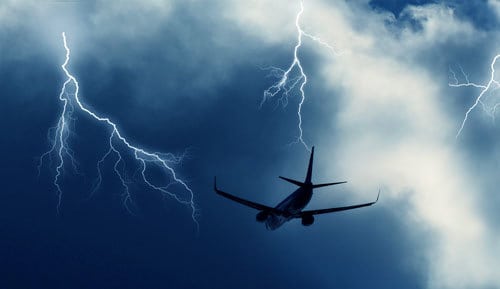
Apart from snow or icy weather, this is the type of weather that concerns passengers the most. And not without merit. The strong winds, hail, and downdrafts can severely damage or destroy a plane.
Sometimes the cloud system exceeds 35 000 feet (10 670 meters), which is higher than the cruising altitude of an airliner. They can also be up to 12 miles (19.3 kilometers) wide. This makes it difficult for an aircraft to fly over or around in some cases.
It does not mean planes cannot fly during thunderstorms. But pilots try and avoid flying through it at all costs. Today's accurate weather forecasts allow airlines to plan ahead and create flight plans to avoid thunderstorms.
Even if a thunderstorm develops unexpectedly, the radars in modern airplanes cannot only detect heavy clouds ahead but "see" inside the clouds to determine their density. It allows pilots to decide whether to reroute their planes or carry on through a storm system.
Luckily, the design of more robust and durable aircraft, combined with accurate weather forecasts and advanced radar systems, resulted in no fatal crashes in recent times.
The bottom line is that aircraft can fly in thunderstorms but prefer to reroute and fly around them. Only as a last resort will pilots fly through one, and the design of modern aircraft allows them to withstand the majority of light to mild thunderstorms.
Can Airplanes Fly In Rain?
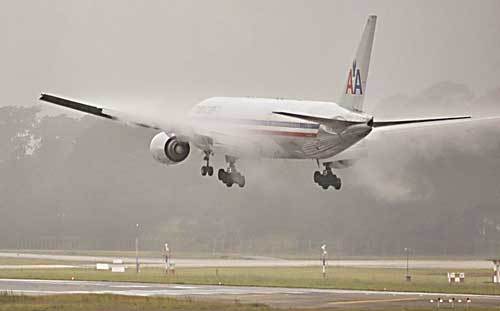
In the vast majority of cases, the answer is yes. Rain can look much worse than it is, and modern airports and aircraft are more than able to withstand a substantial amount of rain.
There are exceptions and a few dangers, though. One of the side-effects of heavy rainfall is reduced visibility. In extreme cases, pilots may have to abort the takeoff during showers until visibility is restored to a safe level.
On rare occasions, if an aircraft flies through a heavy shower, an engine flameout can occur (where the flame in the engine's combustion chamber is extinguished, causing it to stop). In basically every instance, though, a pilot can restart the engine if such an event occurs.
Freezing rain occurs in the upper troposphere, where water droplets below freezing point freeze on contact with objects. It can freeze on an aircraft's wings which may cause a plane to stall on rare occasions. In practically every instance, the pilot is able to regain control.
Can Planes Fly In Extreme Cold Weather?
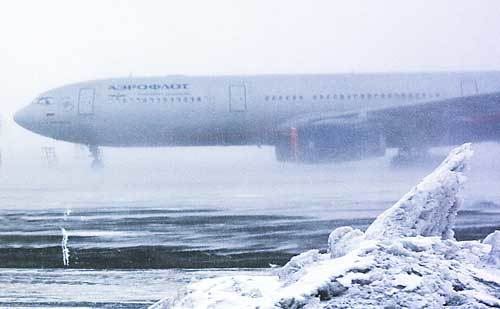
The answer is a definite yes. Cold conditions actually favor the performance of aircraft. Cold air has a high density, which allows aircraft to create lift more quickly and needs less runway for take-offs. Aircraft performance and responsiveness are also better in cold air.
Aviation fuels can cool down to -40° Fahrenheit (-40° Celsius) before freezing on the ground, which means ground staff only need to keep the temperature above this level. In the air, the fuel is kept warm as it moves through the engine.
If you take into consideration the fact that at cruising altitude, the average temperature is -70° Fahrenheit (-57° Celsius), you will realize that cold conditions pose no real threat to aircraft and airports.
What is a danger, though, is the conditions that accompany cold weather. We will look at these conditions in the following sections.
When Do Flights Get Cancelled Due To Snow?
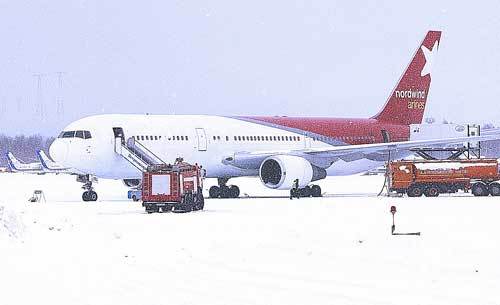
If enough moisture is present in the air, freezing conditions can quickly lead to the occurrence of snow. Although a light snowfall will not cause much concern (as long as the runway remains clear), a heavy snow shower can lead to significant problems.
As soon as a layer of snow and or sludge is present on the runway, it becomes unsafe, and airport authorities will prevent aircraft from taking off or landing until the runway is cleared.
A layer of snow or sludge makes a runway slippery and can cause aircraft to hydroplane or slide when trying to take off or land, which can lead to potentially fatal accidents.
Another factor that can be influenced by snow, especially when the wind is blowing as well, is visibility. As soon as a snow shower starts to limit visibility to the point where pilots and authorities deem it to be too dangerous, aircraft will not be allowed to take off.
Ultimately, it is up to an individual airport's ground control staff and pilots to make the final decision on whether or not to fly in snowy conditions.
Can Aircraft Take Off Or Land In Icy Conditions?
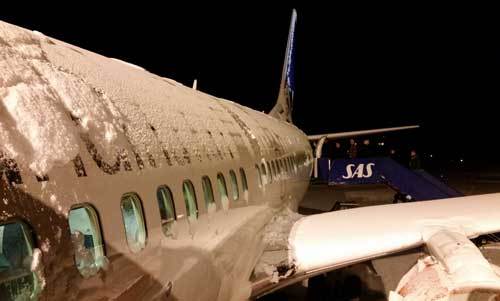
The same dangers and resulting restrictions that apply to snow or sludge on a runway also apply to ice on the asphalt of airports. Ice that melts often causes an ice-covered runway, as low temperatures cause it to freeze again and form a layer of ice.
Ice on a runway is even more slippery than snow or sludge, and although it poses the most significant danger for aircraft coming into land, it makes taking off very difficult as well.
What causes extended delays in these conditions is the fact that ice is very hard to remove from a runway. Ground staff is also wary of using aggressive methods to clear ice off the asphalt, as the equipment can easily damage the surface (or pavement) of the runway.
The biggest danger, however, is the icing that occurs on aircraft on the ground. The ice that accumulates on the wings, fuselage, and tail of a plane can result in a variety of problems.
The sheer weight of ice alone can cause an aircraft to lose the ability to take off, as not enough lift can be generated to carry the additional mass into the air.
Even if carrying the additional weight is possible, the ice on the wings would have deformed the shape of the wings, as well as freezing the flaps and other mechanisms used for taking off, gaining altitude, and staying in the air.
As a result, de-icing a plane becomes a necessary but time-consuming procedure that must be performed on all aircraft with any amount of ice on them.
This procedure needs to be performed very thoroughly, as even small amounts of ice left on a plane can lead to much bigger problems later on during a flight.
(Icy conditions also have a significant impact on spaceflight, where it can affect the launch of an orbital rocket. Learn more about how cold conditions and other meteorological events can lead to the failure and possible explosion of launch vehicles in the following article.)
Can Planes Take Off In High Winds?
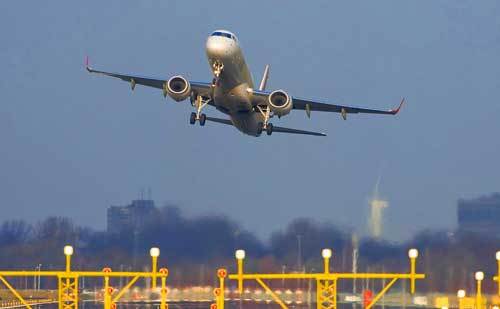
The answer is yes, in most cases. Modern aircraft are designed to withstand a tremendous amount of pressure caused by severe winds. Since air movement is such an integral part of aviation, pilots also get extensively trained to cope with every kind of wind condition.
There are limitations, however, when extreme wind conditions are present. Depending on the size and weight of an aircraft, combined with the wind speed, airports and pilots can set their own restrictions on when conditions are too dangerous to take off.
Why Can't Airplanes Take Off in Extreme Heat?

Heat is probably the last thing that comes to mind when you think of possible weather conditions that will adversely affect aviation.
It has a much larger effect on takeoffs and landings than you may think. The first problem that heat creates is that air expands in warm conditions. In extreme heat, the air expands so much that aircraft cannot generate enough lift under their wings to become airborne.
The runway length required by airplanes to gain enough speed to take off or slow down after landing is just not currently available at any international airports.
Aircraft engines already generate a substantial amount of heat. When very hot conditions exist in the atmosphere, it can severely impede the engine's performance. It includes its ability to maintain a steady rate of climb and the ability to stay airborne after takeoffs.
Extreme heat can also cause an aircraft engine to exceed its maximum operating temperature, which can cause damage, and in severe cases, lead to engine failure.
Conclusion
By answering some of the most frequently asked questions about inclement weather and air travel, this article endeavored to explain how weather affects aviation in different ways.
After reading this post, I trust you will have a much better understanding of how both airports and aircraft operations are influenced and put under pressure by increasingly volatile and extreme weather conditions.
Never miss out again when another interesting and helpful article is released and stay updated, while also receiving helpful tips & information by simply clicking on this link .
Until next time, keep your eye on the weather!

